Abstract
Objective
Recently smartphones and tablets have spread in developed countries, and healthcare‐related apps are growing incredibly in different specialties. The aim of this study is to provide an up‐to‐date review of the current OtoHNS (otolaryngology–head and neck surgery) apps developed for patients.
Methods
This mobile applications review was conducted in September 2017. Relevant apps about OtoHNS were searched in the Apple Store and in the Google Play using various keywords. We included helpful apps for OtoHNS patients. Apps for medical students, physician (95 apps) and non‐English apps (6 apps) were excluded.
Results
At the end of our selection process, 216 apps have been included for mobile applications review. The number of apps published per year in OtoHNS has increased each year. The most common apps were about hearing, in particular 63 of 216 (29%) were hearing test; 75 of 216 (35%) for tinnitus treatment; 10 of 216 (5%) for sounds measurement around the patients; and 7 of 216 (3%) to treat vertigo. One hundred thirty‐seven of 216 (63%) apps were free of charge. Physicians were clearly involved in the app's development in only 73 of 216 (34%) apps. One hundred sixty‐three of 216 (75%) had no user ratings.
Conclusions
Apps are increasingly and easily accessible, although their use in clinical practice is not yet totally accepted. Our review showed that most apps have been created with no guidance from otolaryngologist. Further steps are needed to regulate apps’ development. Hoping an “App Board,” such as editorial board for scientific journal, to assess app quality, validity, and effectiveness before they can be fully incorporated into clinical practice and medical education.
Level of Evidence
N/A
Keywords: Mobile applications, apps, patients, Apple Store, Google Play
INTRODUCTION
Mobile smartphone and tablet have become ubiquitous, allowing users to perform a variety of functions through third‐party applications (apps), which can be downloaded from online app stores. The largest app stores are Apple's App Store (iOS) and Google Play (Android). The world of medical and healthcare applications available for smartphones and tablets is expanding. The Apple Store and Google Play account for 126,000 and 105,000 health apps, respectively.1, 2, 3
Recent studies have examined the apps available in different specialties, first of all in orthopedic surgery, dermatology, and pain management4, 5, 6, 7, 8, 9, 10, 11, 12, 13, 14, 15 but, despite the extensive use of mobile devices and apps in medicine, there has been limited research on apps in otolaryngology–head and neck surgery (OtoHNS).16
In 2015, a Canadian group wrote a very interesting review about the apps that may be useful for practicing otolaryngologists.17 Seventy‐five unique apps relating to OtoHNS were found at the time the search was conducted; the majority of apps that were available in the Apple Store could be potentially be integrated into everyday clinical use. Useful clinical guides and handbooks were in the top user‐rated apps. In the last years, mobile apps have drastically increased.18, 19, 20 The aim of this study is to provide an up‐to‐date review of the current OtoHNS apps developed for patients.
METHODS
Search Methods for Identification of Apps
Relevant mobile applications relating to otolaryngology were searched in the Apple Store and Google Play using, according to previous review,17 the following keywords: “head and neck surgery,” “head and neck,” “otolaryngology,” “rhinology,” “otology,” “laryngology,” “ENT,” “ear nose throat,” “ear,” “nose,” and “throat.” After searching with these generic keywords, we used more specific keywords probably used by patients: “tinnitus,” “Meniere,” “dizziness,” “otitis,” “otosclerosis,” “hearing loss,” “sore throat,” “tonsillitis,” “hoarseness,” “sinusitis,” and “nasal obstruction.”
Three authors (AC, AF, and MG) independently evaluated the description of each app, by selecting the ones on the basis of its OtoHNS contents with no limit for the year of updating and language. The search returned 317 OtoHNS apps. Apps for medical students, physician (95 apps), and non‐English apps (6 apps) were excluded (Fig. 1).
Figure 1.
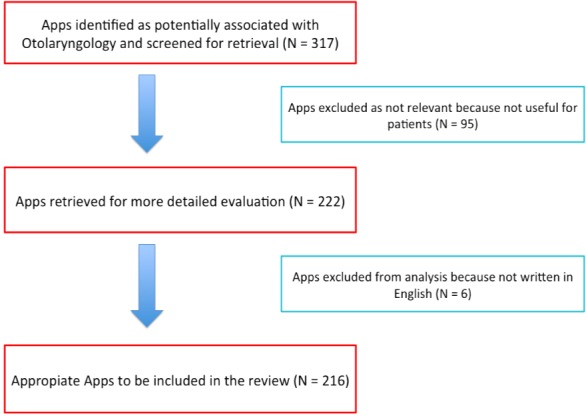
Flow‐chart of apps research for mobile applications review
RESULTS
As result of our search conducted in September 2017, 216 OtoHNS apps for patients were included in the present review: 157 apps were found in the Apple Store (73%), 71 in the Google Play (33%), and 12 (6%) were available in both stores.
There were some differences about available information about apps: Apple shows information about year of creation and number of updates, Google instead only shows the date of last update.
One (0.5%) app was updated in 2009, 4 (2%) in 2010, 6 (3%) in 2011, 10 (5%) in 2012, 11 (5%) in 2013, 20 (9%) in 2014, 46 (21%) in 2015, 71 (33%) in 2016, and 47 (21%) in 2017 (Fig. 2).
Figure 2.
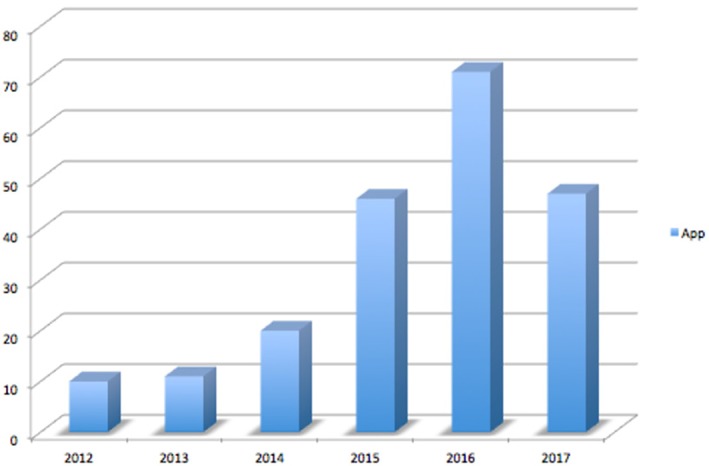
App's last update
Considering the creation of Apple store's app: 1 (0.6%) was created in 2008, 3 (2%) in 2009, 9 (6%) in 2010, 11 (7%) in 2011, 12 (8%) in 2012, 19 (12%) in 2013, 20 (13%) in 2014, 34 (22%) in 2015, 29 (18%) in 2016, and 19 (12%) in 2017 (Fig. 3).
Figure 3.
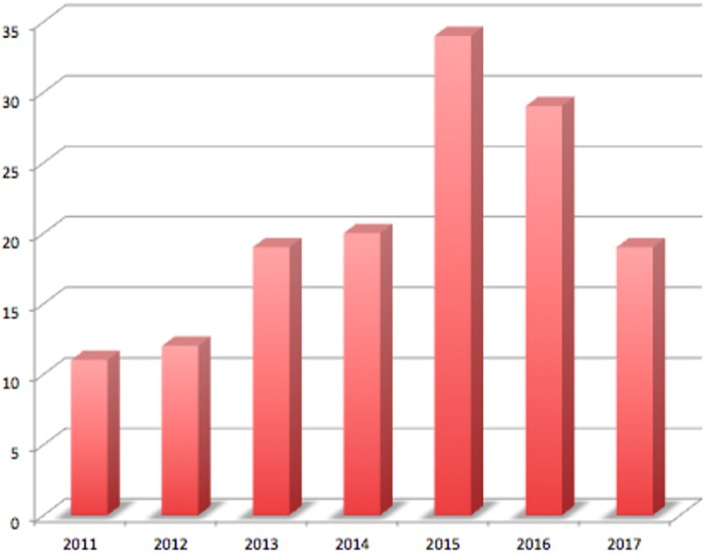
App's creation (Apple)
The average updates were 3.5 per app, and only 41 apps (26%) did not have any updates after creation.
Accessibility (Price)
One hundred thirty‐seven (63%) of the apps were free of charge. The average price for each app that is fully paid before downloading was €5.51, with a range of €0.49 to €28.99. Only one app differs greatly from the others with a cost of €449.99: “Quietude” is the replication of a FDA approved hardware on the Apple store, it was developed for tinnitus’ therapy with different sounds customized for single patient. Almost all apps required full payment before downloading. Only a few apps allow to download a free model to test and, if satisfied, they could buy full content.
Developer Information
We evaluated the physician's involvement in the app development assessing the store information; we observed that in only 73 of 216 (34%) apps physicians were clearly involved in the app development.
User Ratings and Downloads
Considering all Google and Apple OtoHNS apps, 163 (75%) had no user ratings; in particular, in the Apple store only 2 (1%) and in the Google store 54 (76%) showed user ratings. Twenty‐six apps (12%) had more than 10 ratings, and only 9 apps (5%) had more than 100 ratings. Among the apps with more ratings were: “Tinnitus sound,” “StopTinnitus,” and “Relax Noise 3” (141, 375, and 647 ratings, respectively) which generate sounds that give temporary relief to people with tinnitus as part of a tinnitus management program; and “Speak for me App” (352 ratings) is helpful for patients who have lost their voice and need another communication method. “Hearing test” and “SoundCheck” (513 and 145 ratings) measure environmental noise levels and evaluate patients own hearing to determine if it is within a normal range, or if they have potential hearing loss. All these apps were found in the Google store.
Date on the number of downloads was available only in the Google store apps as shown in Figure 4.
Figure 4.
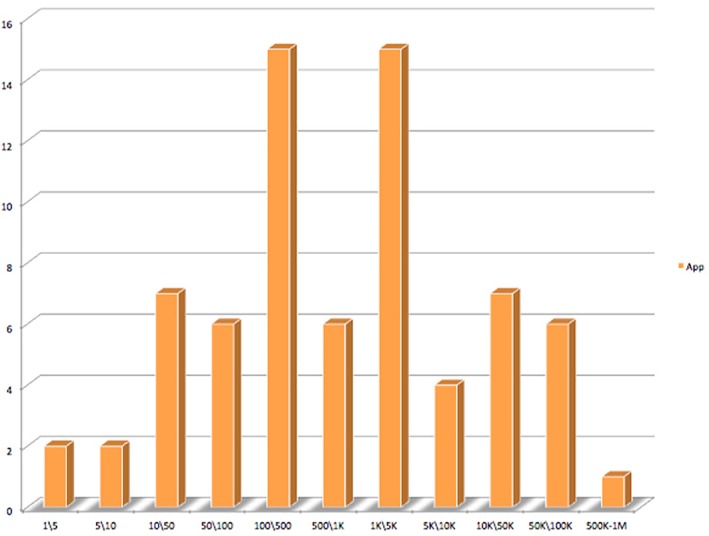
Number of downloads (Android)
Fifty‐four (76%) apps had at least 100 downloads and 14 (20%) apps had more than 10,000. According to our expectations, apps that have the largest number of downloads were also those with more user ratings previously described.
CATEGORIES
Considering the 216 OtoHNS apps designed for patients, we can divide them into four categories: 78 (36%) were included in the category “Diagnosis,” 121 (56%) in the category “Therapy,” 7 (3%) “Diagnosis/Therapy,” and 10 (5%) in the category “InTouch,” apps to facilitate the ENT‐patient contact (Fig. 5)
Figure 5.
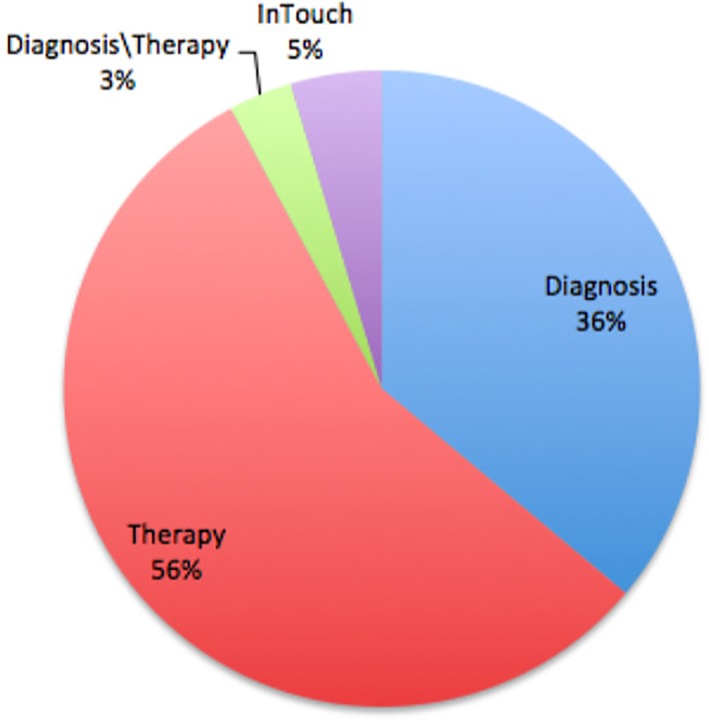
Categories
The most common apps were about the hearing, in particular 63 of 216 (29%) were hearing test; 75 of 216 (35%) for tinnitus treatment; 10 of 216 (5%) for sounds measurement around the patients; and 7 of 216 (3%) to treat vertigo (Fig. 6).
Figure 6.
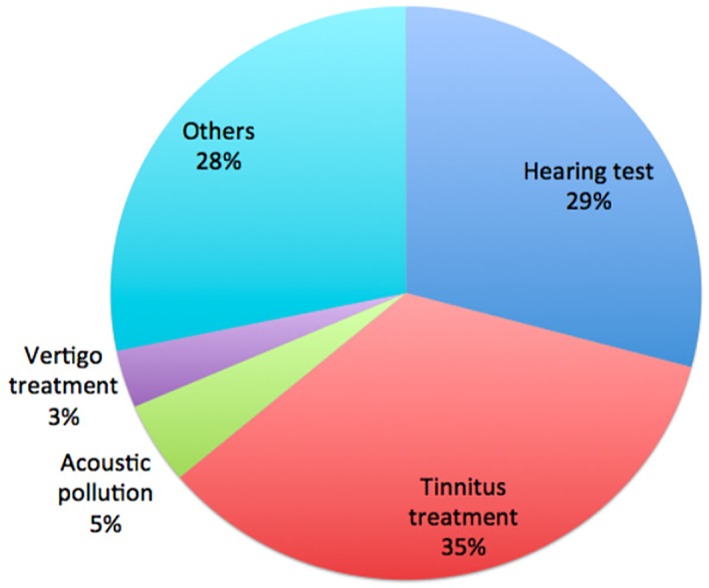
Main functions
Among all categories, the most rated app in the Apple store was “Mimi hearing test,” an auditory screening test, which could be done at home with headphones in a simple and inexpensive way. It evaluates the entire range of frequencies from 100 to 12000 Hz, and designs an audiogram. It allows patients to evaluate hearing abilities over time, obviously with some differences compared to a specialized audiometric center.
In the “Therapy” category, two kinds of applications elicited our attention: nasal bleeding home management and tinnitus relief.
The apps concerning epistaxis contain information about the causes of nosebleed, some home strategies to stop it and information to prevent epistaxis.
The app concerning tinnitus contains information about tinnitus prevalence, possible causes, pathogenesis mechanisms, and some relief strategies. It provides exercises and advice to help patients’ tinnitus management. The app includes three different white sounds and patients can choose the one that masks tinnitus best. It is useful to reduce tinnitus but also to relax, reduce anxiety, and increase concentration.
“Entlink” was certainly the most representative app in the category “InTouch.” It allowed patients to find the closest ENT specialist from their mobile devices. The patient selected location, distance and subcategory specialization, and then the app provided a list of ENT specialists including directions, maps, phone numbers, how to navigate there, and more.
DISCUSSION
Technological innovation plays an increasingly large role in healthcare, supported by growing Internet accessibility and the spreading of smartphones and tablets.21 Apps developed to help manage health conditions are becoming more accessible and gaining in popularity.22 The number of apps published per year in OtoHNS has increased as shown in Figure 3, which is consistent with the continuing expansion of the mobile app market. We included in the review 216 apps available mostly in the app store (73%), the majority of the Aapps (63%) were free, underlining the easy accessibility for each patient.
This study had some limitations. Our study includes OtoHNS for patients; medical apps directed to physicians and trainees in otolaryngology were omitted, according to exclusion criteria. We were also limited by the information available in the different app stores and it was often difficult to compare Apple with Google stores; for example, in the Apple store we have information on the year of creation and all the updates, on the contrary in the Google store we have the date of last update and number of downloads.
The ideal role of medical apps is to provide instructions, information, and to promote behaviors finalized to help patients learn more about their own health. Apps are not meant to be a substitute for medical counsel, instead they could serve as an initial screening to incentivize patients to seek medical counsel to investigate their concerns. Considering the exponential improvements in complexity, quality, and processing power of the modern smartphone, apps can be also used in developing countries as low‐cost screening to assess initial health problems or to inform patients about healthy behaviors, improve adherence to therapy, or to provide answers to simple doubts. In order to do so, apps should be correctly built and should provide correct medical advices.
The app market is spreading for several reasons. Firstly, there is a lot of demand of apps, considering the diffusion of smartphones; secondly, the process of app creations has been progressively simplified and made affordable for the consumer but mostly for the app developers. Those reasons, while having a lot of positive aspects, raise some concerns.
This liberty brings to the fact that everyone can develop and publish any kind of apps, not excluding health‐related apps. The major app stores provide a quality control only regard the possible presence of security issues, “over the line” behavior, but not about the content of the app itself.23
The main concern is about the nature of the apps we are reviewing: health‐related apps can be published without any control on the data they present to the public. In addition, only 73 of 216 (34%) of the apps stated that physicians were involved in development. This low level of physician involvement in app development raises quality issues and concerns regarding the accuracy of app content. Some of those apps are validated by doctors, and their validation is well described in some cases also in literature, but those cases are extremely rare.
The majority of apps (particularly in the Apple store) do not have user ratings (53 of 216, 25%). This is a sign of both low patient apps use and low patient feedback. Furthermore, the vast majority of apps (203 of 216, 94%) did not have in‐app references for content. These quality assurance issues make it difficult to determine the accuracy of app content and provide barriers to apps becoming incorporated into clinical use and medical education.
The content was reviewed for many apps, but the actual lack of “guidelines” did not allow us to rate the single app. We cannot define app quality only based on our views, also considering the great variability of app content.
We believe that steps should be taken to regulate app development and to ensure quality and accuracy of content. As apps become more prevalent in OtoHNS, guidance from otolaryngologists is required to assess app quality, validity, and effectiveness before they can be fully incorporated into clinical practice and medical education. In the short term, we envision an “App Board” whereby a commission of physicians reviews apps, such as editorial board for scientific journal. Suggesting an app regarding health without a “medical warranty” increases the risk of treatment failure and can expose physicians to legal problems, so further research is necessary to validate the commercially available apps.
CONCLUSION
In conclusion, we think that apps could represent a valid tool both for patient and physician for screening, for patient education and adherence for medical and surgical treatment, and for complement therapies for wide range of ENT pathologies, but a form of control is, in our opinion, desirable.
Conflicts of interest: All authors declare that we have no conflict of interest in connection with this paper.
[Correction added on December 6, 2018, after first online publication: Author names were corrected.]
BIBLIOGRAPHY
- 1. MHealth App Developer Economics 2016. Available at: https://research2guidance.com/product/mhealth-app-developer-economics-2016/. Accessed October 2016.
- 2. Anderson, M. Pew Research Center . 2015. Technology device ownership: 2015. Available at: http://www.pewinternet.org/2015/10/29/technology‐device‐ownership‐2015/. Accessed August 2, 2016.
- 3. Fox S, Duggan M. Pew Research Center. 2012. Mobile Health 2012. Available at: http://www.pewinternet.org/files/old-media//Files/Reports/2012/PIP_MobileHealth2012_FINAL.pdf. Accessed August 2, 2016.
- 4. Franko O. Smartphone apps for orthopaedic surgeons. Clin Orthop Relat Res 2011;469:2042–2048. [DOI] [PMC free article] [PubMed] [Google Scholar]
- 5. Hamilton A, Brady R. Medical professional involvement in smartphone ‘‘apps’’ in dermatology. Br J Dermatol 2012;167:220–221. [DOI] [PubMed] [Google Scholar]
- 6. Rosser B, Eccleston C. Smartphone applications for pain management. J Telemed Telecare 2011;17:308. [DOI] [PubMed] [Google Scholar]
- 7. Kraidin J, Ginsberg S, Solina A. Anesthesia apps: overview of current technology and intelligent search techniques. J Cardiothorac Vasc Anesth 2012;26:322–326. [DOI] [PubMed] [Google Scholar]
- 8. Oehler R, Smith K, Toney J. Infectious diseases resources for the iPhone. Clin Infect Dis 2010;50:1268–1274. [DOI] [PubMed] [Google Scholar]
- 9. O'Neill S, Brady RR. Colorectal smartphone apps: opportunities and risks. Colorectal Dis 2012;14:530–534. [DOI] [PubMed] [Google Scholar]
- 10. Abboudi H, Amin K. Smartphone applications for the urology trainee. BJU Int 2011;108:1371–1375. [DOI] [PubMed] [Google Scholar]
- 11. Tseng J. Review of neurosurgical smartphone applications. J MTM 2012;1:4–10. [Google Scholar]
- 12. Al‐Hadithy N, Ghosh S. Smartphones and the plastic surgeon. J Plast Reconstr Aesthet Surg 2013;66:e155–e161. [DOI] [PubMed] [Google Scholar]
- 13. Szekely A, Talano R, Bagyi P. Smartphones, tablets and mobile applications for radiology. Eur J Radiol 2013;82:829–836. [DOI] [PubMed] [Google Scholar]
- 14. Mohan A, Branford O. iGuide to plastic surgery: iPhone apps, the plastic surgeon, and the health care environment. Aesthet Surg J 2012;32:653–658. [DOI] [PubMed] [Google Scholar]
- 15. Bender JL, Yue RY, To MJ, Deacken L, Jadad AR. A lot of action, but not in the right direction: systematic review and content analysis of smart‐phone applications for the prevention, detection, and management of cancer. J Med Internet Res 2013;15:e287. [DOI] [PMC free article] [PubMed] [Google Scholar]
- 16. Pope L, Silva P, Almeyda R. iPhone applications for the modern day otolaryngologist. Clin Otolaryngol 2010;35: 350–354. [DOI] [PubMed] [Google Scholar]
- 17. Wong MC, Fung K. Mobile applications in otolaryngology–head and neck surgery. Otolayngol Head Neck Surg 2015;152:638–643. [DOI] [PubMed] [Google Scholar]
- 18. Franko O, Tirrell T. Smartphone app use among medical providers in ACGME training programs. J Med Syst 2012;36:3135–3139. [DOI] [PubMed] [Google Scholar]
- 19. Cummiskey M. There's an app for that. Smartphone use in health and physical education. J Phys Educ Recreat Danc 2011;82:24–30. [Google Scholar]
- 20. Kratzke C, Cox C. Smartphone technology and apps: rapidly changing health promotion. Int Electron J Health Educ 2012;15:72–82. [Google Scholar]
- 21. Fiordelli M, Diviani N, Schulz PJ. Mapping mHealth research: a decade of evolution. J Med Internet Res 2013;15:e95. [DOI] [PMC free article] [PubMed] [Google Scholar]
- 22. Dennison L, Morrison L, Conway G, Yardley L. Opportunities and challenges for smartphone applications in supporting health behavior change: qualitative study. J Med Internet Res 2013;15:e86. [DOI] [PMC free article] [PubMed] [Google Scholar]
- 23. App Store Review Guidelines . Available at: https://developer.apple.com/app-store/review/guidelines/.


